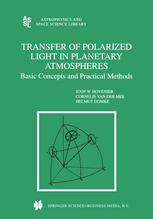

Most ebook files are in PDF format, so you can easily read them using various software such as Foxit Reader or directly on the Google Chrome browser.
Some ebook files are released by publishers in other formats such as .awz, .mobi, .epub, .fb2, etc. You may need to install specific software to read these formats on mobile/PC, such as Calibre.
Please read the tutorial at this link: https://ebookbell.com/faq
We offer FREE conversion to the popular formats you request; however, this may take some time. Therefore, right after payment, please email us, and we will try to provide the service as quickly as possible.
For some exceptional file formats or broken links (if any), please refrain from opening any disputes. Instead, email us first, and we will try to assist within a maximum of 6 hours.
EbookBell Team

4.1
60 reviewsThe principal elements of the theory of polarized light transfer in planetary atmospheres are expounded in a systematic but concise way. Basic concepts and practical methods are emphasized, both for single and multiple scattering of electromagnetic radiation by molecules and particles in the atmospheres of planets in the Solar System, including the Earth, and beyond. A large part of the book is also useful for studies of light scattering by particles in comets, the interplanetary and interstellar medium, circumstellar disks, reflection nebulae, water bodies like oceans and suspensions of particles in a gas or liquid in the laboratory.
Throughout the book symmetry principles, such as the reciprocity principle and the mirror symmetry principle, are employed. In this way the theory is made more transparent and easier to understand than in most papers on the subject. In addition, significant computational reductions, resulting from symmetry principles, are presented. Hundreds of references to relevant literature are given at the end of the book. Appendices contain supplementary information such as a general exposition on properties of matrices transforming Stokes parameters of light beams. Each chapter concludes with a number of problems with answers or hints for solution.
The readers should have some basic knowledge of physics and mathematics. The book is suitable as a textbook for advanced undergraduates and graduate students. It will also be of interest to science professionals in one of the many disciplines in which electromagnetic scattering plays an important role, like astrophysics, atmospheric optics, remote sensing, marine optics, biophysics and biomedicine.